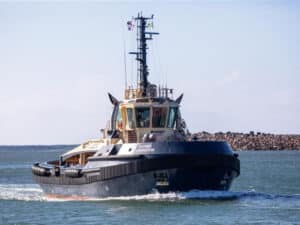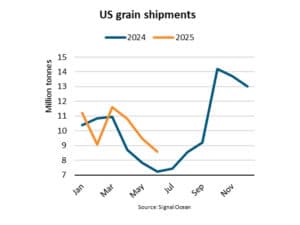
OPINION: Time to address “sea blindness” on digital transformation
Written by Marine Log Staff
Martin Wallgren, Chief Information Officer at GAC Group.
By Martin Wallgren, Chief Information Officer at GAC Group
Done right, digital transformation has boundless potential for shipping. But doing it right demands resilience, the right mindset and a clear focus on those selling and buying digital services.
Digitalization has tremendous potential for the shipping industry, but it comes with the pitfalls of inflated expectations and blind spots.
The subject started trending in shipping circles about five years ago, with discussions around big data preceded by broader conversations around digitalization.
Now, other topics are joining the discussion, including drones and artificial intelligence. The “big” in ‘”big data” has been dropped in favor of further-reaching conversations about its transformational role for the sector.
Shipping is one of the last sectors to be transformed by technology, even falling behind other laggards such as banking. This is partly because vessels are expensive assets, so digital transformation comes with higher risks compared to other industries.
Shipping’s rich heritage means it has many legacy solutions, which have created a type of technical debt which makes it tempting to choose a simple or more limited immediate solution rather than adopting a better approach that would take longer and cost more.
Nevertheless, many in shipping support digitalization to remain relevant and useful—not just to incumbents of one of the world’s oldest industries, but also to the broader global community with vested interests in it. But how do we cut through the noise to focus attention and investment on what really matters to unlock its true power?
START-UP MENTALITY
At GAC, we recognized the opportunities and challenges of digitalization early and launched Pegasus, a digital transformation program in 2017. Rather than focusing on big words and lofty ambitions, we aspired to really study how the structure and culture at GAC could be transformed to drive greater customer value.
We had to think like a start-up, focusing on our customers and reinventing our processes to cut the steps required to get business done, reduce paperwork and automate as much of the decision-making process as possible.
This reflected the changing mindset of our customers, and made us take a step back and re-ask critical questions such as how, in an ideal world, a port call will be managed or freight tracked?
New digital technologies present solutions to big questions that may have previously been considered insurmountable. GAC’s crew change module is a good example, and its one that has been thoroughly tested during the crew change crisis brough about by the COVID-19 pandemic.
It uses machine learning to transform the crew sign-on process, automatically reading passports for key information which is fed into a secure database. It reinvents a previously manual process, boosting efficiency and improving turnaround times and accuracy.
We foresee a time in the not too distant future when this system can be expanded to provide a single secure digital ID system for seafarers throughout their journey to and from their vessels of work—covering hotel bookings, flights accommodation, and more.
A similar digital ID system could also bring big benefits for the growing number of home-based workers, for example with a more efficient onboarding process that eliminates the need to travel to the office to share key personal identification documents.
INTEGRATING & CONNECTING HIGH QUALITY DATA
We have sought to carefully re-examine every aspect of the process to give customers the best possible experience through digital means, and in doing so we have found news ways to optimize the value of GAC’s longstanding role as a data conduit for global businesses and their employees.
We have analyzed our entire freight services system, assessing each step, removing redundant elements, integrating and connecting high quality data to make information flow more successfully, helping to eradicate poor customer service.
It puts data at customers fingertips, and enables real time reporting, allowing problems to be addressed before they become critical. Pre-existing data becomes more powerful and works harder when collated in a digital system.
HUMAN ELEMENT IS KEY
However, it’s important not to rely solely on the technology for digital transformation. New software is useless if the people using it do not understand how it works to help them in their tasks. This is particularly true in the shipping industry, which is highly fragmented and has a strong emphasis on long-term personal relationships, many of which remain wholly analogue.
An “educate, train and change mindset” is critical for successful digital transformation. GAC’s early and sustained emphasis on e-training, delivered by the GAC Corporate Academy, has been crucial in building and sustaining the foundational skills and mindsets needed for the company to successfully thrive in the digital era. They don’t have to be complex; even security refreshers and Office 365 refresher training have proved to be game changers.
HOLISTIC
Transformation takes careful thought and a long-term holistic view emphasising customer satisfaction, business outcomes and people.
Digitalization in shipping comes with its own unique challenges, due to of its expensive assets, long history and market fragmentation. There are many questions still left to answer, and crystal clear focus on customer-centric solutions communicated clearly throughout the business will be key to making business stronger and driving real change.




